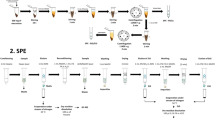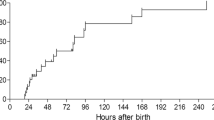Abstract
Presence of fatty acid ethyl esters (FAEE), ethyl glucuronide (EtG), and ethyl sulfate (EtS) in meconium, the first neonatal feces, identifies maternal alcohol consumption during pregnancy. Current meconium alcohol marker assays require separate analyses for FAEE and EtG/EtS. We describe development and validation of the first quantitative liquid chromatography tandem mass spectrometry assay for 9 FAEEs, EtG, and EtS in 100 mg meconium. For the first time, these alcohol markers are analyzed in the same meconium aliquot, enabling comparison of the efficiency of gestational ethanol exposure detection. 100 mg meconium was homogenized in methanol and centrifuged. The supernatant was divided, and applied to two different solid phase extraction columns for optimized analyte recovery. Limits of quantification for ethyl laurate, myristate, linolenate, palmitoleate, arachidonate, linoleate, palmitate, oleate, and stearate ranged from 25–50 ng/g, with calibration curves to 2,500–5,000 ng/g. EtG and EtS linear dynamic ranges were 5–1,000 and 2.5–500 ng/g, respectively. Mean bias and between-day imprecision were <15 %. Extraction efficiencies were 51.2–96.5 %. Matrix effects ranged from −84.7 to 16.0 %, but were compensated for by matched deuterated internal standards when available. All analytes were stable (within ±20 % change from baseline) in 3 authentic positive specimens, analyzed in triplicate, after 3 freeze/thaw cycles (−20 °C). Authentic EtG and EtS also were stable after 12 h at room temperature and 72 h at 4 °C; some FAEE showed instability under these conditions, although there was large inter-subject variability. This novel method accurately detects multiple alcohol meconium markers and enables comparison of markers for maternal alcohol consumption.

ᅟ


Similar content being viewed by others
References
Burd L, Klug MG, Martsolf JT, Kerbeshian J (2003) Fetal alcohol syndrome: neuropsychiatric phenomics. Neurotoxicol Teratol 25(6):697–705
Greenbaum RL, Stevens SA, Nash K, Koren G, Rovet J (2009) Social cognitive and emotion processing abilities of children with fetal alcohol spectrum disorders: a comparison with attention deficit hyperactivity disorder. Alcohol Clin Exp Res 33(10):1656–1670
Jones KL, Smith DW, Ulleland CN, Streissguth P (1973) Pattern of malformation in offspring of chronic alcoholic mothers. Lancet 1(7815):1267–1271
Substance Abuse and Mental Health Services Administration (2013) Results from the 2012 National Survey on Drug Use and Health: Summary of National Findings, NSDUH Series H-46, HHS Publication No. (SMA) 13-4795. Substance Abuse and Mental Health Services Administration, Rockville.
Suttie M, Foroud T, Wetherill L, Jacobson JL, Molteno CD, Meintjes EM, Hoyme HE, Khaole N, Robinson LK, Riley EP, Jacobson SW, Hammond P (2013) Facial dysmorphism across the fetal alcohol spectrum. Pediatrics 131(3):e779–e788
Mattson SN, Riley EP, Gramling L, Delis DC, Jones KL (1997) Heavy prenatal alcohol exposure with or without physical features of fetal alcohol syndrome leads to IQ deficits. J Pediatr 131(5):718–721
Borucki K, Schreiner R, Dierkes J, Jachau K, Krause D, Westphal S, Wurst FM, Luley C, Schmidt-Gayk H (2005) Detection of recent ethanol intake with new markers: comparison of fatty acid ethyl esters in serum and of ethyl glucuronide and the ratio of 5-hydroxytryptophol to 5-hydroxyindole acetic acid in urine. Alcohol Clin Exp Res 29(5):781–787
Albermann ME, Musshoff F, Madea B (2012) A high-performance liquid chromatographic-tandem mass spectrometric method for the determination of ethyl glucuronide and ethyl sulfate in urine validated according to forensic guidelines. J Chromatogr Sci 50(1):51–56
Laposata M (1999) Fatty acid ethyl esters: nonoxidative ethanol metabolites with emerging biological and clinical significance. Lipids 34(Suppl):S281–S285
Treloar T, Madden LJ, Winter JS, Smith JL, de Jersey J (1996) Fatty acid ethyl ester synthesis by human liver microsomes. Biochim Biophys Acta 1299(2):160–166
Foti RS, Fisher MB (2005) Assessment of UDP-glucuronosyltransferase catalyzed formation of ethyl glucuronide in human liver microsomes and recombinant UGTs. Forensic Sci Int 153(2–3):109–116
Schneider H, Glatt H (2004) Sulpho-conjugation of ethanol in humans in vivo and by individual sulphotransferase forms in vitro. Biochem J 383(Pt. 3):543–549
Ernhart CB, Morrowtlucak M, Sokol RJ, Martier S (1988) Underreporting of alcohol use in pregnancy. Alcohol Clin Exp Res 12(4):506–511
Sokol RJ, Martier S, Ernhart C (1983) Identification of alcohol abuse in the prenatal clinic. In: Chang NC, Chao M (eds) Early identification of alcohol abuse. Alcohol, Drug Abuse, and Mental Health Administration Research. Monograph No. 17: 209-227. Rockville
Halter CC, Dresen S, Auwaerter V, Wurst FM, Weinmann W (2008) Kinetics in serum and urinary excretion of ethyl sulfate and ethyl glucuronide after medium dose ethanol intake. Int J Legal Med 122(2):123–128
Hoiseth G, Bernard JP, Karinen R, Johnsen L, Helander A, Christophersen AS, Morland J (2007) A pharmacokinetic study of ethyl glucuronide in blood and urine: applications to forensic toxicology. Forensic Sci Int 172(2–3):119–124
Borucki K, Dierkes J, Wartberg J, Westphal S, Genz A, Luley C (2007) In heavy drinkers, fatty acid ethyl esters remain elevated for up to 99 hours. Alcohol Clin Exp Res 31(3):423–427
Gray T, Huestis M (2007) Bioanalytical procedures for monitoring in utero drug exposure. Anal Bioanal Chem 388(7):1455–1465
Bakdash A, Burger P, Goecke TW, Fasching PA, Reulbach U, Bleich S, Hastedt M, Rothe M, Beckmann MW, Pragst F, Kornhuber J (2010) Quantification of fatty acid ethyl esters (FAEE) and ethyl glucuronide (EtG) in meconium from newborns for detection of alcohol abuse in a maternal health evaluation study. Anal Bioanal Chem 396(7):2469–2477
Kwak HS, Kang YS, Han KO, Moon JT, Chung YC, Choi JS, Han JY, Kim MY, Velazquez-Armenta EY, Nava-Ocampo AA (2010) Quantitation of fatty acid ethyl esters in human meconium by an improved liquid chromatography/tandem mass spectrometry. J Chromatogr B Anal Technol Biomed Life Sci 878(21):1871–1874
Moore C, Jones J, Lewis D, Buchi K (2003) Prevalence of fatty acid ethyl esters in meconium specimens. Clin Chem 34(1):133–136
Pichini S, Pellegrini M, Gareri J, Koren G, Garcia-Algar O, Vall O, Vagnarelli F, Zuccaro P, Marchei E (2008) Liquid chromatography-tandem mass spectrometry for fatty acid ethyl esters in meconium: assessment of prenatal exposure to alcohol in two European cohorts. J Pharm Biomed Anal 48(3):927–933
Morini L, Marchei E, Pellegrini M, Groppi A, Stramesi C, Vagnarelli F, Garcia-Algar O, Pacifici R, Pichini S (2008) Liquid chromatography with tandem mass spectrometric detection for the measurement of ethyl glucuronide and ethyl sulfate in meconium: new biomarkers of gestational ethanol exposure? Ther Drug Monit 30(6):725–732
Tarcomnicu I, van Nuijs AL, Aerts K, De Doncker M, Covaci A, Neels H (2010) Ethyl glucuronide determination in meconium and hair by hydrophilic interaction liquid chromatography-tandem mass spectrometry. Forensic Sci Int 196(1–3):121–127
Jones R, Williams L, Senior A, Davies G, Lodder H, Jordan S, Vandell V, Jones G, Desbrow C (2012) Evaluation of SPE strategies for the simultaneous extraction of ethyl glucuronide and ethyl sulfate prior to LC-MS/MS analysis. Society of Forensic Toxicologists 2012 Annual Meeting Boston, MA, USA. Poster available at http://appnotes.biotage.com/filearea/appnotes/120/SOFT_EVOLUTE-EtG-EtS_FinalPN45.pdf
Scientific Working Group for Forensic Toxicology (2013) Scientific Working Group for Forensic Toxicology (SWGTOX) standard practices for method validation in forensic toxicology. J Anal Toxicol 37(7):452–474
Matuszewski BK, Constanzer ML, Chavez-Eng CM (2003) Strategies for the assessment of matrix effect in quantitative bioanalytical methods based on HPLC-MS/MS. Anal Chem 75(13):3019–3030
Joya X, Friguls B, Ortigosa S, Papaseit E, Martinez SE, Manich A, Garcia-Algar O, Pacifici R, Vall O, Pichini S (2012) Determination of maternal-fetal biomarkers of prenatal exposure to ethanol: a review. J Pharm Biomed Anal 69:209–222
Morini L, Marchei E, Vagnarelli F, Garcia Algar O, Groppi A, Mastrobattista L, Pichini S (2010) Ethyl glucuronide and ethyl sulfate in meconium and hair-potential biomarkers of intrauterine exposure to ethanol. Forensic Sci Int 196(1–3):74–77
Pichini S, Morini L, Marchei E, Palmi I, Rotolo MC, Vagnarelli F, Garcia-Algar O, Vall O, Zuccaro P (2009) Ethylglucuronide and ethylsulfate in meconium to assess gestational ethanol exposure: preliminary results in two Mediterranean cohorts. Can J Clin Pharmacol 16(2):e370–e375
Albermann ME, Musshoff F, Madea B (2011) Comparison of ethyl glucuronide (EtG) and fatty acid ethyl esters (FAEEs) concentrations in hair for testing abstinence. Anal Bioanal Chem 400(1):175–181
Pragst F, Yegles M (2008) Determination of fatty acid ethyl esters (FAEE) and ethyl glucuronide (EtG) in hair: a promising way for retrospective detection of alcohol abuse during pregnancy? Ther Drug Monit 30(2):255–263
Moore CM, Lewis D (2001) Fatty acid ethyl esters in meconium: biomarkers for the detection of alcohol exposure in neonates. Clin Chim Acta 312(1–2):235–237
Kronstrand R, Brinkhagen L, Nystrom FH (2012) Ethyl glucuronide in human hair after daily consumption of 16 or 32 g of ethanol for 3 months. Forensic Sci Int 215(1–3):51–55
Matlow JN, Lubetsky A, Aleksa K, Berger H, Koren G (2013) The transfer of ethyl glucuronide across the dually perfused human placenta. Placenta 34(4):369–373
Shah R, Lacourse WR (2006) An improved method to detect ethyl glucuronide in urine using reversed-phase liquid chromatography and pulsed electrochemical detection. Anal Chim Acta 576(2):239–245
Zheng Y, Helander A (2008) Solid-phase extraction procedure for ethyl glucuronide in urine. J Anal Toxicol 32(9):778–781
Jones J, Jones M, Plate C, Lewis D (2012) The detection of 1-palmitoyl-2-oleoyl-sn-glycero-3-phosphoethanol and ethyl glucuronide in human umbilical cord. Am J Anal Chem 3:800–810
Bernhardt TG, Cannistraro PA, Bird DA, Doyle KM, Laposata M (1996) Purification of fatty acid ethyl esters by solid-phase extraction and high-performance liquid chromatography. J Chromatogr B Biomed Appl 675(2):189–196
Scheidweiler KB, Desrosiers NA, Huestis MA (2012) Simultaneous quantification of free and glucuronidated cannabinoids in human urine by liquid chromatography tandem mass spectrometry. Clin Chim Acta 413(23–24):1839–1847
Bearer CF, Lee S, Salvator AE, Minnes S, Swick A, Yamashita T, Singer LT (1999) Ethyl linoleate in meconium: a biomarker for prenatal ethanol exposure. Alcohol Clin Exp Res 23(3):487–493
Kinnunen PM, Lange LG (1984) Identification and quantitation of fatty acid ethyl esters in biological specimens. Anal Biochem 140(2):567–576
Zelner I, Hutson JR, Kapur BM, Feig DS, Koren G (2012) False-positive meconium test results for fatty acid ethyl esters secondary to delayed sample collection. Alcohol Clin Exp Res 36(9):1497–1506
Morini L, Groppi A, Marchei E, Vagnarelli F, Algar OG, Zuccaro P, Pichini S (2010) Population baseline of meconium ethyl glucuronide and ethyl sulfate concentrations in newborns of nondrinking women in 2 Mediterranean cohorts. Ther Drug Monit 32(3):359–363
Chan D, Bar-Oz B, Pellerin B, Paciorek C, Klein J, Kapur B, Farine D, Koren G (2003) Population baseline of meconium fatty acid ethyl esters among infants of nondrinking women in Jerusalem and Toronto. Ther Drug Monit 25(3):271–278
Coughtrie MW, Burchell B, Leakey JE, Hume R (1988) The inadequacy of perinatal glucuronidation: immunoblot analysis of the developmental expression of individual UDP-glucuronosyltransferase isoenzymes in rat and human liver microsomes. Mol Pharmacol 34(6):729–735
Onishi S, Kawade N, Itoh S, Isobe K, Sugiyama S (1979) Postnatal development of uridine diphosphate glucuronyltransferase activity towards bilirubin and 2-aminophenol in human liver. Biochem J 184(3):705–707
Author information
Authors and Affiliations
Corresponding author
Rights and permissions
About this article
Cite this article
Himes, S.K., Concheiro, M., Scheidweiler, K.B. et al. Validation of a novel method to identify in utero ethanol exposure: simultaneous meconium extraction of fatty acid ethyl esters, ethyl glucuronide, and ethyl sulfate followed by LC-MS/MS quantification. Anal Bioanal Chem 406, 1945–1955 (2014). https://doi.org/10.1007/s00216-013-7600-z
Received:
Revised:
Accepted:
Published:
Issue Date:
DOI: https://doi.org/10.1007/s00216-013-7600-z




